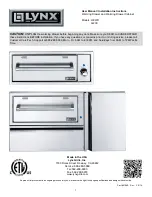
24
25
HEat gUIdE
The following oven temperature settings are included as a guide. These settings may need to
be adjusted to suit the individual oven.
tHERMoStat SEttINgS
dESCRIptIoN oF oVEN
tEMpERatURES
°C ELECtRIC °F
°C gaS °F
gaS MaRK
Very slow
120 250 120 250 1
Slow
150 300 150 300 2
Moderately slow
170 325
160 325
3
Moderate
180 350
180 350
4
Moderately hot
200 400 190 375
5
Hot
220
425 200 400 6
Very hot
230 450 230 450 7
If using fan forced ovens be sure to turn the temperature down by 15-20°C.
Also check recipes at the back of this book.
MEaSURINg & WEIgHINg
Measuring and weighing ingredients
The accuracy of measurements can affect the
critical balance of the recipe. Use accurate and
appropriate measuring equipment to ensure
the best results.
Do not use tableware, or common cups or
spoons when measuring ingredients.
dry measuring cups & spoons
For dry ingredients, use nested plastic or
metal dry measuring cups and spoons. Do
not use tableware cups or spoons.
It is important to spoon or scoop the dry
ingredients loosely into the cup. Do not tap
the cup or pack the ingredients into the cup
unless otherwise directed (eg. packed brown
sugar). The extra amount gained from
packing or tapping down ingredients can
affect the critical balance of the recipe. Level
the top of the cup by sweeping the excess
with the back of a knife.
When using measuring spoons for either
liquid or dry ingredients such as yeast,
sugar, salt, dry milk or honey, measurements
should be level, not heaped.
Liquid measuring cups
For liquid ingredients, use transparent
plastic or glass liquid measuring cups with
the measurements marked clearly on the
side. Do not use non-transparent plastic
or metal measuring cups unless they have
measurement markings on the side.
Measuring cup must be on a flat and
horizontal surface. For accuracy, bend
to view the liquid level at eye level. An
inaccurate measurement can affect the
critical balance of the recipe.
Units of measurement
Some units of measurement are different in
different countries. Please consider the guide
below if using recipes from international
sources.
Cups
•
250ml for Australia, New Zealand & UK
•
237ml for USA
Tablespoons
•
20ml for Australia
•
15ml for New Zealand, UK and USA
Teaspoons
•
5ml for all regions.












































